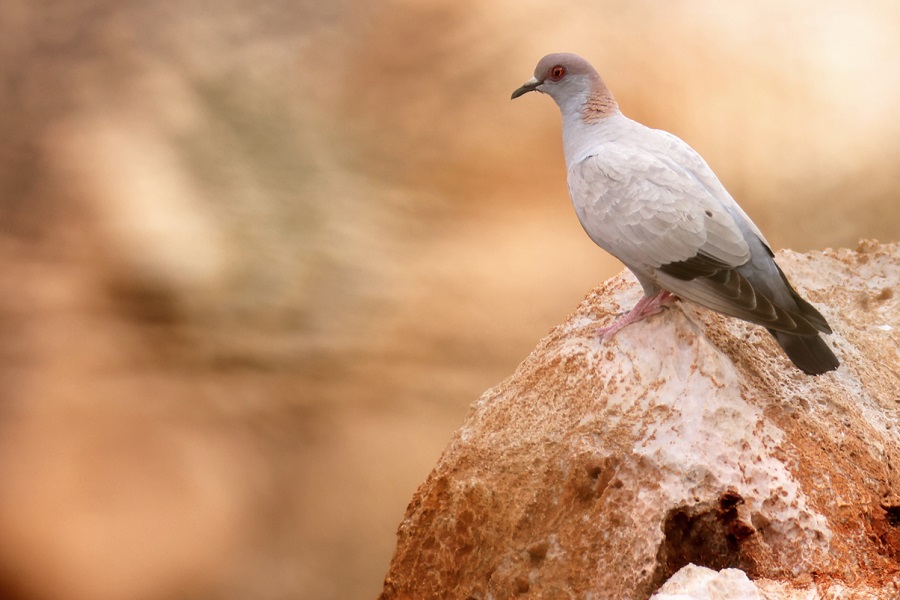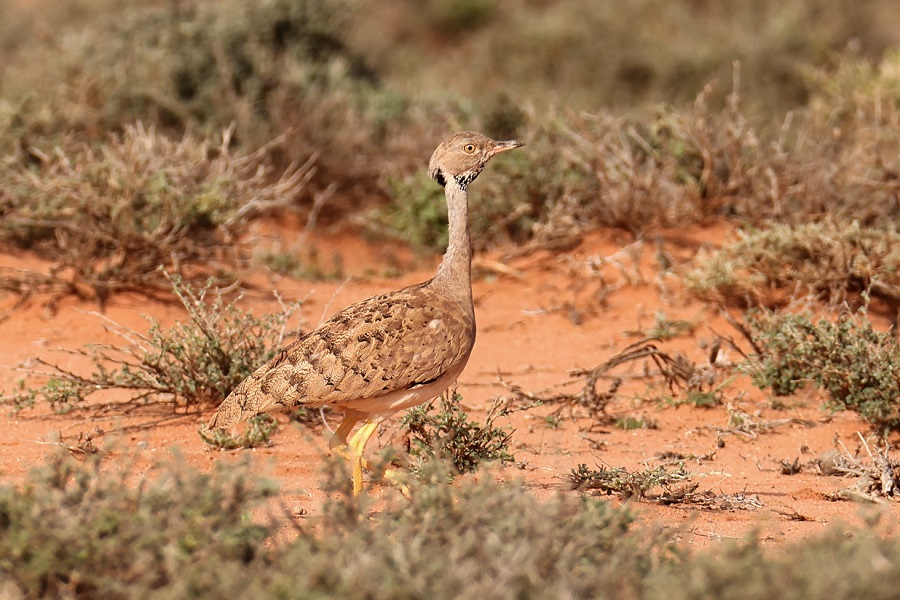Somaliland & Djibouti
We will be exploring several sites that are now being visited by more birders every year to see all the possible Horn of Africa endemics and regional specialties not found in Ethiopia. These include Archer’s Buzzard, Djibouti Francolin, Little Brown Bustard, Somali Pigeon, Somali Lark, Collared Lark, Lesser Hoopoe Lark, Somali Wheatear, Somali Thrush, Philippa’s Crombec, Somali Starling, Somali Sparrow, Somali Golden-winged Grosbeak, and hopefully Warsangli Linnet. We will be running a particularly small group, travelling in two 4WDs with plenty of space for people and bags. Efforts to increase tourism have recently simplified the visa process, while our ground agent and security escort will be fully up-to-date with the latest safety advisories.
Next Dates
1 May - 14 May 2026 (14 days)
Leaders:
Joachim Bertrands
Group Size Limit:
5
Single Room Supplement: $
500 USD
Deposit: $
750 USD
Price: $
6900 USD
Add a Title
Leaders:
Joachim Bertrands
Group Size Limit:
Add a Title
Single Room Supplement: $
TBD
Deposit: $
TBD
Price: $
TBD
Add a Title
1 May - 14 May 2027 (14 days)
Leaders:
Joachim Bertrands
Group Size Limit:
5
Single Room Supplement: $
500 USD
Deposit: $
750 USD
Price: $
7200 USD
Add a Title
Leaders:
Joachim Bertrands
Group Size Limit:
Add a Title
Single Room Supplement: $
TBD
Deposit: $
TBD
Price: $
TBD
Add a Title
While Somaliland is always lumped in with the lawless neighbour for government travel advisory purposes, there have been no attacks targeting foreigners since 2008. Efforts to increase tourism have recently simplified the visa process, while our ground agent and security escort will be fully up-to-date with the latest safety advisories.
We will be running a particularly small group, travelling in two 4WDs with plenty of space for people and bags. Our tour price includes the cost of the flight from Somaliland to Djibouti.
Accommodation:
Mostly comfortable accommodation, but with basic hotel in Berbera.
Walking difficulty:
Mostly easy and flat, though some longer walks required as we search for the endemic larks on rocky plains.
Tour cost includes:
All accommodation, main meals, drinking water, internal flights (as stated in itinerary), overland transport, tips to local drivers and guides, travel permits, entrance fees, and guide fees.
Tour cost excludes:
Flights before and after the tour start/end, visa, travel insurance, tips to tour leaders, laundry, drinks, and other items of a personal nature.


Day 1: The tour starts this afternoon at Hargeisa, the capital city of Somaliland, where we will spend two nights. Around our hotel we should already see the very common Somali Bulbul.
Day 2: We will have a full day birding around Hargeisa, heading down to the southern plains where we will visit several sites and look for our first set of rarely-observed Horn of Africa endemics, such as Little Brown Bustard, Somali Wheatear, Somali Lark, and Rufous-capped Lark. While the lost Russet Lark (AKA Sharpe's Lark) was known from this area and probably still occurs, it hasn't been documented since 1968. Some more widespread birds also found in Ethiopia might include Somali Courser, Somali Bee-eater, Somali Fiscal, Gillett’s Lark, Short-tailed Lark, Thekla's Lark, and Chestnut-headed Sparrow-Lark.
Day 3: Transit to the city of Burco / Burao for a three night stay. We have our first attempt at seeing Somali Pigeon on the way through Berbera, but will be able to try again on the way back too.
Day 4-5: Birding the surrounds of Burco for some of the mega specialties of Somaliland. One of the most exciting is Collared Lark, a truly attractive member of the family which inhabits remote red dunes in the Horn of Africa. On nearby plains we will also be wanting to see Lesser Hoopoe Lark (one species certainly deserving of this name when compared to the Greater counterpart), and perhaps have our first sightings of Somali Short-toed Lark. Many of the larks we searched for on Day 2 are here too if needed, plus the stately Heuglin’s Bustard and perhaps the poorly-known "Wajir" Pale Flycatcher (presence of this form here still needs confirmation).
Dense thornscrub in holds the important near-endemic Philippa’s Crombec (AKA Short-billed Crombec), along with Somali Crombec, Yellow-vented Eremomela, Mouse-coloured Penduline Tit, Red-and-yellow Barbet, Red-naped Bushshrike, Scaly Chatterer, and specifically the tricky Northern Grosbeak-Canary. We will search for the beautiful Donaldson Smith's Nightjar after dark, which probably would win the contest for most beautiful Caprimulgus if not for his cousin in the Western Sahara! More widespread species could include Banded Parisoma, Golden-breasted Starling, Superb Starling, Shelley's Starling, Hunter's Sunbird, Purple Grenadier, White-bellied Canary, Somali Bunting, and the northern form of Black-cheeked Waxbill.
Day 6: We will transit across the Banade Plains, making stops for the other subspecies of Lesser Hoopoe-Lark or any of the other specialty larks we may still need. There are usually lots of White-crowned Starling in this area. Overnight in Ceerigaabo / Erigavo.
Day 7-8-9: Three full days of birding at Daallo Forest for the special endemics: Archer’s Buzzard, Somali Thrush, Somali Golden-winged Grosbeak, and the threatened Warsangli Linnet. Isolated populations of both Arabian Scops Owl and Socotra White-eye can be seen here, both of which might end up being undescribed species (or at least subspecies)! The extremely rare Archer's Francolin has been recorded on occasion, while a new undescribed species of cisticola is easily found. More widespread birds include Hemprich's Hornbill, Nubian Woodpecker, Black-billed Woodhoopoe, Grey-headed Batis, Somali Tit, Brown Woodland Warbler, Somali Starling, Little Rock Thrush, Abyssinian Wheatear, Shining Sunbird, Swainson's Sparrow, Brown-rumped Seedeater, and Striolated Bunting.
Day 10: Retracing our steps back across the Banade Plains to Burco.
Day 11: We can retry any of the missing arid zone endemics this morning before driving to the coast near Berbera. Exploring rocky ravines late this afternoon should produce our final endemic, the beautiful Somali Pigeon. There is also a chance for Brown-tailed Rock Chat, while the attractive Somali Sparrow is common in town for close approach and photos. Overnight in Berbera.
Day 12: Last chance for Somali Pigeon if needed before driving back to Hargeisa for a midday flight to Djibouti City. On arrival we will immediately transfer west, searching for the lovely Nile Valley Sunbird on our way to the Goda Mountains for overnight.
Day 13: We have until mid-afternoon for our Djibouti Francolin search, which should be successful fairly early in the morning at a new site where the Critically Endangered species has rebounded to higher numbers. After looking for a few more nice birds like Yellow-breasted Barbet, Ethiopian Boubou, and Rüppell's Weaver, we will work back along the coast road as the sun lowers behind us in the west. This hopefully will allow us to find the big three Laridae of the Red Sea: White-eyed Gull, Sooty Gull, and White-cheeked Tern. Overnight back in Djibouti City.
Day 14: Morning birding in search of Arabian Golden Sparrow, then transfers to the airport for the end of the tour.
NOTE: This tour can be linked with Saudi Arabia in 2027. Due to the difficulty of obtaining travel insurance for Somaliland, we have sourced a specialised medical evacuation provider which operates in the country. All participants must take out a two-week policy with them before travel, costing approximately $250 USD.
























